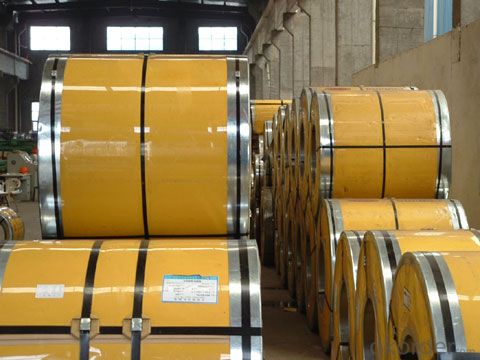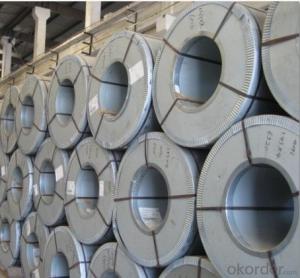Stainless Steel Coil Cold Rolled 304 Surface 2B With Good Quality
- Loading Port:
- Shanghai
- Payment Terms:
- TT OR LC
- Min Order Qty:
- 100 m.t.
- Supply Capability:
- 8000 m.t./month
OKorder Service Pledge
OKorder Financial Service
You Might Also Like
Stainless Steel Coil Cold Rolled 304 Surface 2B With Good Quality
1.Structure of Stainless Steel Coil Cold Rolled 304 Surface 2B With Good Quality
Cold Rolled stainless steel Coil with good quality is one of the raw material of the cold rolled stainless steel Coil, which can be used directly in many places. Stainless Steel (Stainless Steel) is short for acid-proof Stainless Steel, resistant to weak corrosive medium such as air, steam, water, or with a Stainless Steel grade.
2.Main Features of Prefabricated Steel Structure High Building Project
Weldability: The purpose of the different requirement for welding performance are different.1 Kind of tableware generally do not require the performance of welding, even including some pot class enterprise. But the vast majority of products all need raw materials welding performance is good, like the 2 kinds of tableware, thermos flask, steel pipes, water heaters, water dispensers, etc.
3. Stainless Steel Coil Cold Rolled 304 Surface 2B With Good Quality Images


4. Stainless Steel Coil Cold Rolled 304 With Good Quality Specification
The word "stainless steel" is not merely refers to a pure stainless steel, but said more than one hundred kinds of stainless steel industry, the development of each stainless steel has good performance in their specific applications. The key to the success of the first is to make clear purpose, and then determine the correct material. Related to architectural construction applications usually only six types of steel. They contain 17 ~ 22% chromium, good steel contains nickel. Add molybdenum can further improve the atmospheric corrosion resistance, especially containing chloride atmospheric corrosion resistance. Stainless steel often according to the state of organization can be divided intomartensite steel, ferritic steel, austenitic steel, austenitic (two-phase) ferrite stainless steel and precipitation hardening stainless steel, In addition, according to ingredients can be divided into: chromium stainless steel, chromium nickel stainless steel and chromium manganese nitrogen stainless steel, etc.
5. Applications of Stainless Steel Coil 304 With Good Quality
1. Kitchenware: tableware, cookware, Stoves…
2. Food packing: storage cans, food containers…
3. Construction: bridge, roofing, wall, decoration, bathroom accessories…
4. Precision instruments: electrical products, aerospace…
5. Others: automotive parts, machine building, chemical processing, farming…
6.FAQ of Stainless Steel Coil 304 With Good Quality
We have organized several common questions for our clients,may help you sincerely:
①How about your company?
A world class manufacturer & supplier of castings forging in carbon steel and alloy steel,is one of the large-scale professional investment casting production bases in China,consisting of both casting foundry forging and machining factory. Annually more than 8000 tons Precision casting and forging parts are exported to markets in Europe,America and Japan. OEM casting and forging service available according to customer’s requirements.
②How to guarantee the quality of the products?
We have established the international advanced quality management system,every link from raw material to final product we have strict quality test;We resolutely put an end to unqualified products flowing into the market. At the same time, we will provide necessary follow-up service assurance.
③How is the packaging and delivery?
Standard export packing (Coil: waterproof paper + protective steel ring; Circle: wooden box), or as your requirement and the delivery term is based on the project.
- Q:Can stainless steel strips be used in marine vessel construction?
- Indeed, stainless steel strips find practical application in the construction of marine vessels. Offering exceptional resistance to corrosion, stainless steel emerges as an optimal alternative for marine purposes. Withstanding the corrosive nature of saltwater, stainless steel resists rusting and deterioration. In fact, stainless steel strips can be effectively employed in multiple sections of a marine vessel, encompassing the hull, deck, fittings, and equipment. Its robustness, strength, and unwavering resistance to corrosion render stainless steel a dependable material for crafting marine vessels capable of enduring the harsh oceanic conditions.
- Q:Can stainless steel strips be used in the production of water treatment equipment?
- Yes, stainless steel strips can be used in the production of water treatment equipment. Stainless steel is a popular choice in the water treatment industry because of its excellent corrosion resistance properties. It is resistant to rust, staining, and corrosion, making it suitable for use in water treatment equipment that is exposed to water or other corrosive substances. Stainless steel strips are often used to manufacture components such as pipes, tubes, valves, fittings, and filter housings that are essential for the effective and efficient treatment of water. Additionally, stainless steel is easy to clean and maintain, ensuring the longevity and reliability of the water treatment equipment.
- Q:What is the fatigue limit of stainless steel strips?
- The fatigue limit of stainless steel strips refers to the maximum stress level at which the material can endure an infinite number of stress cycles without experiencing fatigue failure.
- Q:Can stainless steel strips be used in food storage containers?
- Indeed, food storage containers can utilize stainless steel strips. Stainless steel emerges as a favored material selection for these containers due to its numerous advantageous qualities. Notably, it exhibits non-reactivity, implying that it does not engage with or modify the taste, appearance, or aroma of the stored food. Moreover, stainless steel boasts corrosion resistance, endowing it with durability and longevity. On top of that, it proves effortless to clean and maintain, while effectively avoiding the retention of unpleasant odors or unsightly stains. These exceptional attributes render stainless steel strips an optimal alternative for food storage containers, guaranteeing the preservation of freshness, safety, and the prevention of contamination.
- Q:What is the corrosion resistance in different environments of stainless steel strips?
- Stainless steel strips are known for their excellent corrosion resistance in various environments. This resistance is primarily due to the presence of chromium in the steel, which forms a passive layer of chromium oxide on the surface. This oxide layer acts as a protective barrier, preventing the underlying metal from being exposed to corrosive elements. In general, stainless steel strips exhibit good corrosion resistance in both atmospheric and aqueous environments. In atmospheric conditions, stainless steel strips can withstand exposure to moisture, oxygen, and pollutants without experiencing significant corrosion. This makes them suitable for outdoor applications such as architectural and marine structures. When it comes to aqueous environments, stainless steel strips offer varying levels of corrosion resistance depending on the specific grade and composition. For instance, austenitic stainless steels, such as Type 304 and 316, are highly resistant to corrosion in most organic and inorganic acids, as well as alkaline solutions. They are commonly used in industries such as chemical processing, food and beverage, and pharmaceuticals. Ferritic stainless steels, on the other hand, have lower corrosion resistance compared to austenitic grades but perform well in mildly corrosive environments such as freshwater and atmospheric exposure. They are often utilized in automotive applications, household appliances, and decorative purposes. Duplex stainless steels combine the best properties of both austenitic and ferritic grades, offering high corrosion resistance in a wide range of environments. They are particularly resistant to stress corrosion cracking and pitting, making them suitable for offshore and marine applications. It is important to note that while stainless steel strips generally have excellent corrosion resistance, their performance can still be influenced by factors such as temperature, concentration of corrosive agents, and mechanical stress. Therefore, it is essential to select the appropriate stainless steel grade based on the specific environment and application to ensure optimal corrosion resistance.
- Q:Are stainless steel strips suitable for furnace parts?
- Yes, stainless steel strips are suitable for furnace parts. Stainless steel is known for its high heat resistance, durability, and corrosion resistance, making it a suitable material for furnace parts that are exposed to high temperatures and harsh environments.
- Q:Can stainless steel strips be used in the production of watches?
- Yes, stainless steel strips can be used in the production of watches. Stainless steel is a popular choice for watch cases and straps due to its durability, corrosion resistance, and aesthetic appeal. It provides a sleek and polished finish, making it suitable for both traditional and modern watch designs.
- Q:Are stainless steel strips magnetic?
- Yes, stainless steel strips can be magnetic depending on their composition and processing. Generally, austenitic stainless steels are non-magnetic, while ferritic and martensitic stainless steels can exhibit magnetic properties.
- Q:What are the common uses of stainless steel strips in the aerospace structural components?
- Due to their unique properties and advantages, stainless steel strips have various applications in aerospace structural components. These include: 1. Providing structural support: Aircraft frame structures often utilize stainless steel strips to ensure strength and stability. They are commonly found in wing spars, fuselage frames, and other load-bearing components. 2. Manufacturing fasteners and connectors: Stainless steel strips are well-suited for aerospace applications where fasteners and connectors are needed. Their high tensile strength, resistance to corrosion, and ability to withstand extreme temperatures make them ideal for securing and joining different structural elements. 3. Constructing exhaust systems: Stainless steel strips are an excellent choice for constructing exhaust systems in aerospace engines. They can withstand the high temperatures and corrosive gases generated by the engines, ensuring the longevity and reliability of the system. 4. Fabricating fuel and hydraulic lines: Stainless steel strips are frequently used in the fabrication of fuel and hydraulic lines within aircraft. Their corrosion resistance and ability to handle high pressures make them reliable for transporting essential fluids throughout the aircraft. 5. Creating heat shields: In aerospace applications, stainless steel strips are utilized in the construction of heat shields. These shields protect sensitive components from the high temperatures generated by engines, enabling proper functionality and extending their lifespan. 6. Manufacturing interior components: Stainless steel strips are also employed in the manufacturing of various interior components such as cabin fittings, seat structures, and galley equipment. Their aesthetic appeal, durability, and resistance to wear and tear enhance the overall passenger experience and ensure safety. In conclusion, stainless steel strips are widely utilized in aerospace structural components due to their strength, corrosion resistance, ability to withstand high temperatures, and reliability. Their versatility and performance make them an essential material in the aerospace industry.
- Q:What is the maximum temperature that stainless steel strips can withstand?
- The maximum temperature that stainless steel strips can withstand depends on the specific grade of stainless steel. However, most stainless steel alloys can withstand temperatures up to 1500 degrees Fahrenheit (815 degrees Celsius) before significant structural changes occur.
1. Manufacturer Overview |
|
|---|---|
| Location | |
| Year Established | |
| Annual Output Value | |
| Main Markets | |
| Company Certifications | |
2. Manufacturer Certificates |
|
|---|---|
| a) Certification Name | |
| Range | |
| Reference | |
| Validity Period | |
3. Manufacturer Capability |
|
|---|---|
| a)Trade Capacity | |
| Nearest Port | |
| Export Percentage | |
| No.of Employees in Trade Department | |
| Language Spoken: | |
| b)Factory Information | |
| Factory Size: | |
| No. of Production Lines | |
| Contract Manufacturing | |
| Product Price Range | |
Send your message to us
Stainless Steel Coil Cold Rolled 304 Surface 2B With Good Quality
- Loading Port:
- Shanghai
- Payment Terms:
- TT OR LC
- Min Order Qty:
- 100 m.t.
- Supply Capability:
- 8000 m.t./month
OKorder Service Pledge
OKorder Financial Service
Similar products
New products
Hot products
Related keywords




























